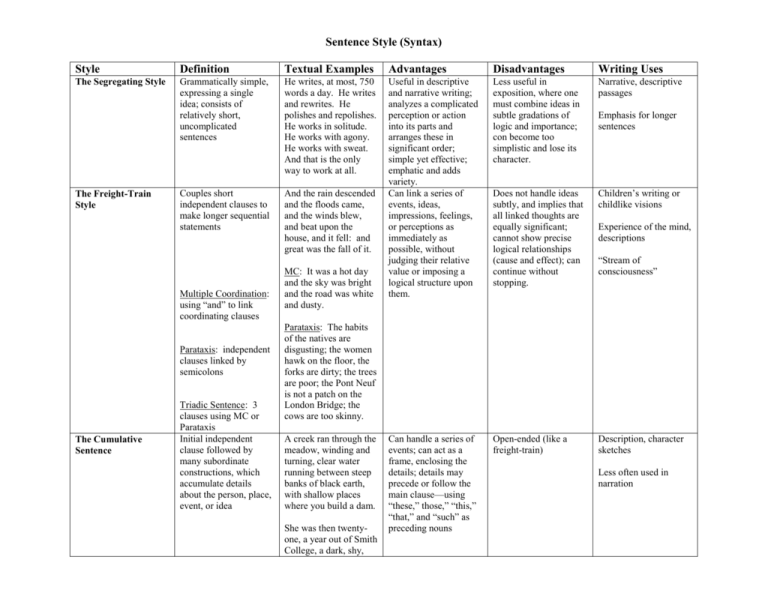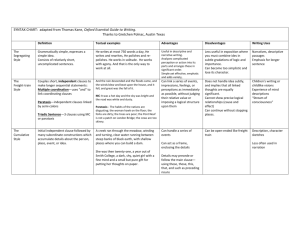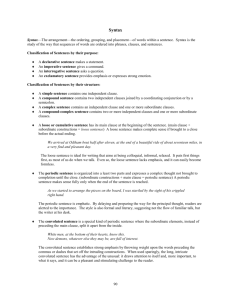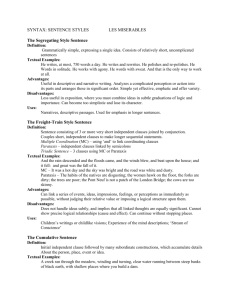File
advertisement

Sentence Style (Syntax) Style Definition Textual Examples Advantages Disadvantages Writing Uses The Segregating Style Grammatically simple, expressing a single idea; consists of relatively short, uncomplicated sentences He writes, at most, 750 words a day. He writes and rewrites. He polishes and repolishes. He works in solitude. He works with agony. He works with sweat. And that is the only way to work at all. Less useful in exposition, where one must combine ideas in subtle gradations of logic and importance; con become too simplistic and lose its character. Narrative, descriptive passages Couples short independent clauses to make longer sequential statements And the rain descended and the floods came, and the winds blew, and beat upon the house, and it fell: and great was the fall of it. Useful in descriptive and narrative writing; analyzes a complicated perception or action into its parts and arranges these in significant order; simple yet effective; emphatic and adds variety. Can link a series of events, ideas, impressions, feelings, or perceptions as immediately as possible, without judging their relative value or imposing a logical structure upon them. Does not handle ideas subtly, and implies that all linked thoughts are equally significant; cannot show precise logical relationships (cause and effect); can continue without stopping. Children’s writing or childlike visions Can handle a series of events; can act as a frame, enclosing the details; details may precede or follow the main clause—using “these,” those,” “this,” “that,” and “such” as preceding nouns Open-ended (like a freight-train) Description, character sketches The Freight-Train Style Multiple Coordination: using “and” to link coordinating clauses Parataxis: independent clauses linked by semicolons The Cumulative Sentence Triadic Sentence: 3 clauses using MC or Parataxis Initial independent clause followed by many subordinate constructions, which accumulate details about the person, place, event, or idea MC: It was a hot day and the sky was bright and the road was white and dusty. Emphasis for longer sentences Experience of the mind, descriptions “Stream of consciousness” Parataxis: The habits of the natives are disgusting; the women hawk on the floor, the forks are dirty; the trees are poor; the Pont Neuf is not a patch on the London Bridge; the cows are too skinny. A creek ran through the meadow, winding and turning, clear water running between steep banks of black earth, with shallow places where you build a dam. She was then twentyone, a year out of Smith College, a dark, shy, Less often used in narration The Parallel Style Two or more words or constructions stand in an identical grammatical relationship to the same thing. All subjects must be in the same form. The Balanced Sentence Two parts, roughly equivalent in length; may also be split on either side. quiet girl with a fine mind and a small but pure gift for her thoughts on paper. In its energy, its lyrics, its advocacy of frustrated joys, rock is one long symphony of protest. In a few moments everything grew black, and the rain poured down like a cataract. Impressive and pleasing to hear; economical— using one element to serve three or four others; enriches meaning by emphasizing subtle connections between words. The constructions may be balanced and parallel. Suits only ideas that are logically parallel—three or four conditions of the same effect; is formal for modern tastes; can be too wordy just by being a parallel structure. Can be used in all forms of writing for emphasis or description—emotional or intellectual. Unsuitable for conveying the immediacy of raw experience or the intensity of strong emotion; formality is likely to seem too elaborate for modern readers. Irony and comedy or just about anything else. Loose sentence: Put things first—the way we talk. Loose sentence: Lacks emphasis and easily becomes formless—no clear ending points Loose sentence: Colloquial, informal, and relaxed Visit either you like; they’re both mad. Children played about her, and she sang as she worked. The subordinating Style Expresses the main clause and arranges points of lesser importance around it, in the form of phrases and independent clauses Loose structure: main clause comes first Loose sentence: We must always be weary of conclusions drawn from the ways of the social insects, since their evolutionary track lies so far from ours The Fragment Periodic structure: main clause follows subordinate parts Periodic sentence: Since there is no future for the black ghetto, the future of all Negroes is diminished. Periodic sentence: Emphatic—it delays the principle thought, increasing climax Periodic sentence: Too long of a delay may cause confusion. Periodic sentence: formal and literal Convoluted structure: main clause is split in two, subordinating parts intruding. Convoluted sentence: White men, at the bottom of their hearts, know this. Convoluted sentence: Simply offers variety in style and emphasis for the words before and after comments Convoluted sentence: Formal and taxing— interrupting elements grow longer and more complicated Convoluted sentence: Formal writing, used sparingly Centered structure: main clause occupies the middle of the sentence Centered sentence: Having wanted to walk on the sea like St. Peter, he had taken an involuntary bath, losing his mitre and the better part of his reputation. Remove the cold and stupid eyeball, it would bleat still, “Ahhhhh,” take off the head, shake out the sawdust, crack the back against the brass bed rail, it would bleat still. The gauze back would slit, and I could see the disk with six holes, the secret of the sound. A mere metal roundness. Centered sentence: Good in long sentences—can order events or ideas. Centered sentence: Not as emphatic as periodic or as informal as loose. Centered sentence: Formal, for long and complicated subjects to include events as well as grammatical order. Emphasis Unsupported fragments become grammatical errors—fixed by rejoining the modifier with the sentence. Formal and informal writing—for emphasis Single word, phrase, or dependent clause standing alone as a sentence Only use occasionally







